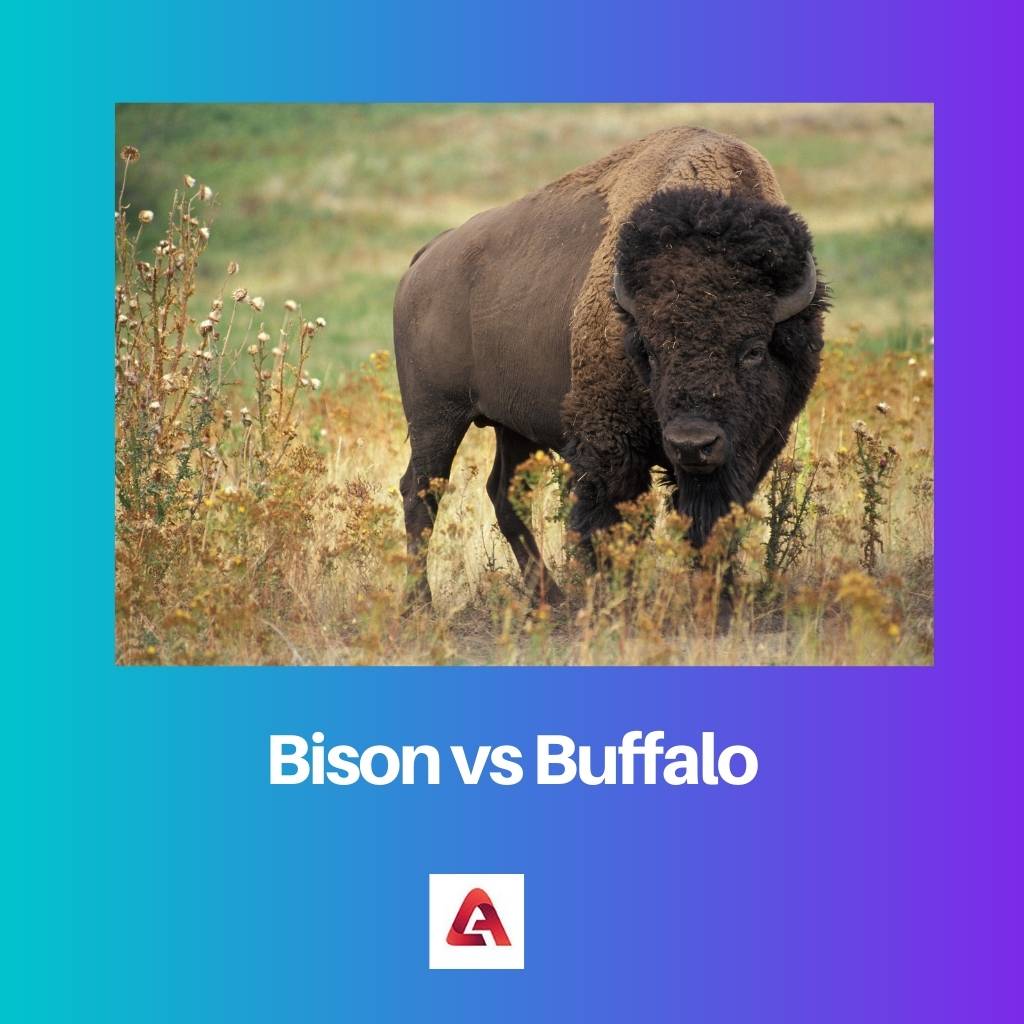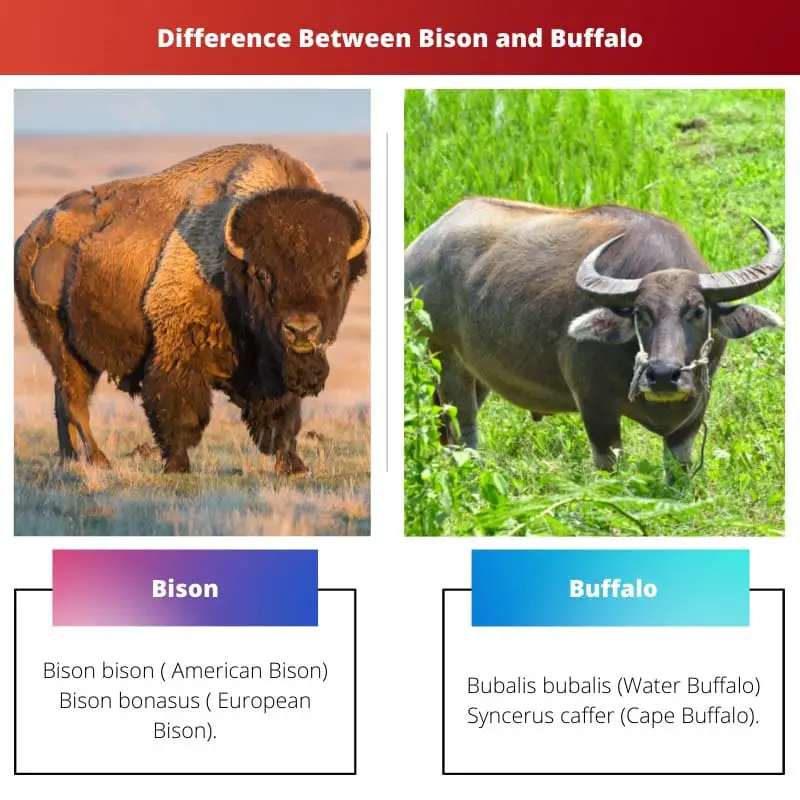It is common to make mistakes while identifying the two animals as both of them are very similar. Sometimes the words are also used interchangeably in some parts of the world.
This is because they both are large herbivores belonging to the family Bovidae. However, some key differences help identify each species.
Key Takeaways
- Bison are native to North America and Europe, while buffalo are found in Africa and Asia.
- Bison have a large hump, a shaggy coat, and shorter horns, while buffalo has no hump, a smooth coat, and long, curved horns.
- Bison are more adaptable to colder climates, while buffalo thrive in warmer environments.
Bison vs Buffalo
Bison are large bovines in the genus Bison. They are found in North America and Europe. They have large humps at their shoulders, beards, as well as thick coats which they shed in the spring and early summer, and bigger heads than buffalo. A buffalo is an American bison native to Africa and Asia.

Bison are even-toed ungulates, meaning they are grazing animals belonging to Bovidae and Genus Bison. Physically they resemble domestic cattle but have a larger asymmetrical body.
Their large headrests on broad shoulders also hold a large muscle hump to support the head. Two large horns are present on their heads that resemble a handlebar’s moustache. They also have what looks like a beard, an outgrowth of fur.
Buffaloes are even-toed ungulates, also belonging to the family Bovidae belonging to the Genus Bubalis and Syncerus. These animals also resemble domestic cattle but have a much more symmetrical body.
They have a comparatively smaller head with larger arched horns. Their hump of muscles is missing owing to the head size. They have smooth dark-coloured bodies without shaggy fur coats.
Comparison Table
| Parameters of Comparison | Bison | Buffalo |
|---|---|---|
| Scientific Name | Bison bison ( American Bison) Bison bonasus ( European Bison) | Bubalis bubalis (Water Buffalo) Syncerus caffer (Cape Buffalo) |
| Genus | All bison belong to the single Genus Bison. | Buffaloes are classified into two genera, Bubalis and Syncerus. |
| Body Size | Bison is naturally larger. | Buffaloes are comparatively smaller. |
| Body Weight | Bison are larger than buffaloes in general and thus weigh more than 1000kgs. | Buffaloes are heavy animals and can weigh up to 900kgs. |
| Heads | They have comparatively large heads. | They have smaller heads in general. |
| Humps | To support the large head they have a large muscle hump on their shoulder. | Muscle hump on the shoulder is absent. |
| Beard | They have extended fur from their lower jaw area that looks like a beard. | Buffaloes are beardless. |
| Horns | They have smaller and sharper horns. | They have larger and arched horns. |
| Legs | They have shorter, stumpy legs. | They have longer, leaner legs. |
| Fur Coat | They have a shaggy winter coat that they shed in the summer. | Buffaloes have smooth thin fur coat that don’t shed. |
| Behaviour | They are more aggressive and cannot be tamed. | Buffaloes are also known to be aggressive but evidence of domestication is found around the world. |
| Age of reproduction | They reproduce upon sexual maturity within two to three years. | Buffaloes however do not breed until six years of age. |
| Home Range | They are limited to parts of America and Europe. | They are found in parts of America, Africa and Asia. |
| Status of Endangerment | Bison is not a nearly endangered species according to the IUCN. | Buffaloes are not considered threatened animals. |
What is Bison?
Bison is a herbivore animal found in parts of America and Europe. They are even-toed grazing animals belonging to the Genus Bison. Generally, they are large animals and are considered to be one of the largest bovines.
They have a huge head that is supported by a muscle hump on their shoulder that makes them top-heavy, which is a characteristic of the species.
Physically they appear like cows but flaunt a beard and sharp horns. They have stumpy short legs making them look heavy. They are confident, aggressive animals that always travel and live in herds.
Usually, they also have a messy fur coat that they shed in the summer and keeps them warm in the winter. They communicate through snorts and grunts.
They are mammals which means they give birth to young ones. They reach sexual maturity at the age of two or three. They are also all-year-round grazers and inhabit the plains. Or areas with ample food and water supply.
They can live up to fifteen to twenty years in the wild. They are aggressive and do not have many predators due to their large size (3.8 m).
Bison was a threatened species of animals, with very few of them living in the wild, but today it has a nearly stable population and is considered a nearly threatened species by the IUCN.

What is Buffalo?
Buffalo is a common term used to describe species belonging to Family Bovidae and Genus Bubalis and Syncerus, meaning water buffalo and cape buffalo, respectively. They are large-bodied grazing animals found across the world, especially in South Asia and Africa.
Physically these large herbivore has a comparatively small head resting on a broad shoulder. It has a dark body colour and is characterized by smooth skin and a thin fur coat. Identifying characteristic of these species is its large arched horns that can decapitate a human if threatened.
They lack any facial fur outgrowth like that in bison. They are mammals and give birth to only one young one. Females do not reproduce until six years of age.
They may be solitary or may live in herds. They are also aggressive and do not have many predators. They weigh around 900 kg and are 3.4 m in length. They prefer to live in damp environments or near a water source.
They are found in swamps and dig characteristic ditches to take mud baths that act as sunscreen. They communicate with moos.

Main Differences Between Bison and Buffalo
- Bison belongs to the Genus Bison, while Buffalo belongs to the Genus Bubalis or Syncerus.
- Bison are larger as well as heavier than buffaloes. Their height alone exceeds 1.5 meters. They weigh between 300-1000 kgs.
- Bison have a large head that has to be supported by the muscle hump on its shoulder. On the other hand, Buffalo have a smaller head without any hump, making the upper part of their body more symmetrical than the anteriorly heavy bison.
- Bison have smaller moustache-shaped horns that are sharp. Buffaloes have longer, more arched horns that can almost extend to a meter.
- Bison are found in a smaller geographical range of habitat than the more widely spread buffalo.
- Bison flaunt a beard and thus are called hipsters of the plain, while buffaloes lack any such beard.
- Bison also have a characteristic thick shaggy winter fur coat that they shed in the summers, while buffaloes have smoother fur.
- Bison were once threatened but today have stable numbers, while buffaloes are a threatened species.

- https://www.cabdirect.org/cabdirect/abstract/19590101319
- https://www.sciencedirect.com/science/article/pii/S0007193517317827

It’s fascinating how bison and buffalo differ in terms of their physical appearance and habitat. They are both impressive animals.
I also found it remarkable how bison are more adaptable to colder climates and buffalo thrive in warmer environments.
Absolutely, the details about their humps, horns, and fur coats are very interesting.
The article effectively delves into the ecological roles and conservation status of bison and buffalo, offering a well-rounded perspective on these species.
Absolutely, the information about their conservation status is crucial for promoting awareness about these animals.
The behavioral attributes and communication methods of bison are fascinating topics that enhance our understanding of these creatures.
The article effectively captures the distinct physical and behavioral traits of bison, contributing to a comprehensive understanding of the species.
I agree, learning about their communication methods provides a deeper insight into their social dynamics.
The information about the behavior and reproduction of bison and buffalo is enlightening. It adds depth to the understanding of these animals.
The details about the status of endangerment of bison and buffalo are also thought-provoking.
I agree, understanding their behavior and breeding patterns is crucial in appreciating their ecological roles.
This article has provided a comprehensive overview of the physical, behavioral, and ecological variances between bison and buffalo, which is valuable for understanding these animals.
I agree, the comprehensive nature of the article adds depth to our knowledge of bison and buffalo.
The information about the behavior and habitat preferences of bison and buffalo is intriguing and enriches our understanding of these animals.
The comparison of the body size, weight, and heads of bison and buffalo provides a comprehensive understanding of their physical differences.
I found the insights about the legs and fur coat of bison and buffalo to be particularly enlightening.
Indeed, the physical distinctions highlighted in the comparison table are immensely informative.
I appreciate the in-depth comparison table between bison and buffalo. It provides a clear overview of their distinctions.
Yes, the table is an excellent summary of their differences across various parameters.
The behavioral differences and age of reproduction between the two species are particularly intriguing.
The details about the age of reproduction and home range are important considerations in studying the ecological aspects of bison and buffalo.
Absolutely, understanding their reproductive patterns and habitat preferences enriches our ecological knowledge.
The article effectively differentiates between bison and buffalo, shedding light on their diverse characteristics and habitats.
I found the section on the size, hump, and horns of bison and buffalo to be particularly informative.
Indeed, it’s a well-presented comparison that clarifies misconceptions about the two animals.
Interesting article, very useful information about the differences between bison and buffalo.
I agree, I didn’t know there were so many differences between the two species.